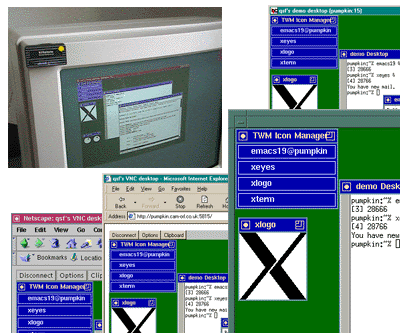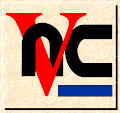|
|
 |
Some recent changes:
Unix packages updated to 3.3.2R3-
14/12/98
rfbcounter source available -
13/12/98
Some updates to the FAQ - 7/12/98
Windows packages updated to 3.3.2R5-
30/10/98
Beta release of the Windows
CE viewer - 21/10/98
Alpha release of the Macintosh
VNC server - 1/10/98
Updates to platforms page
& Java viewer documentation - 24/9/98
Updates to the FAQ - 21/9/98
Reorganisation of contribs
page - 15/9/98
Windows and Unix
packages updated and beta Mac viewer
released- 23/7/98
More updates to the FAQ - 14/7/98
Downloadable versions of the VNC
video available! - 10/7/98
What is VNC? - A practical introduction
VNC stands for Virtual Network Computing. It is, in essence, a remote display
system which allows you to view a computing 'desktop' environment not only
on the machine where it is running, but from anywhere on the Internet and
from a wide variety of machine architectures.

|
The VNC system allows you to access the same desktop
from a wide variety of platforms.
|
Many of us at ORL, for example, use a VNC viewer running on a PC on our
desks to display our Unix environments which are running on a large server
in the machine room downstairs.
What makes it different from other systems?
For this simple mode of operation, you could achieve a similar effect by
installing an X server on your PC. The important factors which distinguish
VNC from other remote display systems such as X are as follows:
-
No state is stored at the viewer. This means you can leave your desk, go
to another machine, whether next door or several hundred miles away, reconnect
to your desktop from there and finish the sentence you were typing. Even
the cursor will be in the same place. With a PC X server, if
your PC crashes or is restarted, all the remote applications will die.
With VNC they go on running.
-
It is small and simple. The Win32 viewer, for example, is about 150K in
size and can be run directly from a floppy. There is no installation needed.
-
It is truly platform-independent. A desktop running on a Linux machine
may be displayed on a PC. Or a Solaris machine. Or any number of other
architectures. The simplicity of the protocol makes it easy to port to
new platforms. We have a Java viewer, which will run in any Java-capable
browser. We have a Windows NT server, allowing you to view the desktop
of a remote NT machine on any of these platforms using exactly the same
viewer. (The NT server is not multi-user - see the documentation).
We developed VNC to give us platform-independence after the success of
our Teleporting system, which
was purely X-based.
-
It is sharable. One desktop can be displayed and used by several viewers
at once, allowing CSCW-style applications.
-
It is free! You can download it, use it, and redistribute it under the
terms of the GNU Public Licence. Both binaries and
source code are available from the download page,
along with a complete copy of this documentation.
Where does the name come from?
The name originates from our development of very-thin-client ATM network
computers. The Videotile was
essentially an LCD display with a pen input and a fast ATM connection.
Because the VNC viewer is a software-only version of this 'ATM Network
Computer', and so provides 'workstations' which can be created or deleted
at will, we named the system Virtual Network Computing.
Can I see what VNC looks like?
We have some screenshots of very simple
VNC desktops running and being displayed on a variety of platforms.
Follow the links on the left to find out more...
|
|

